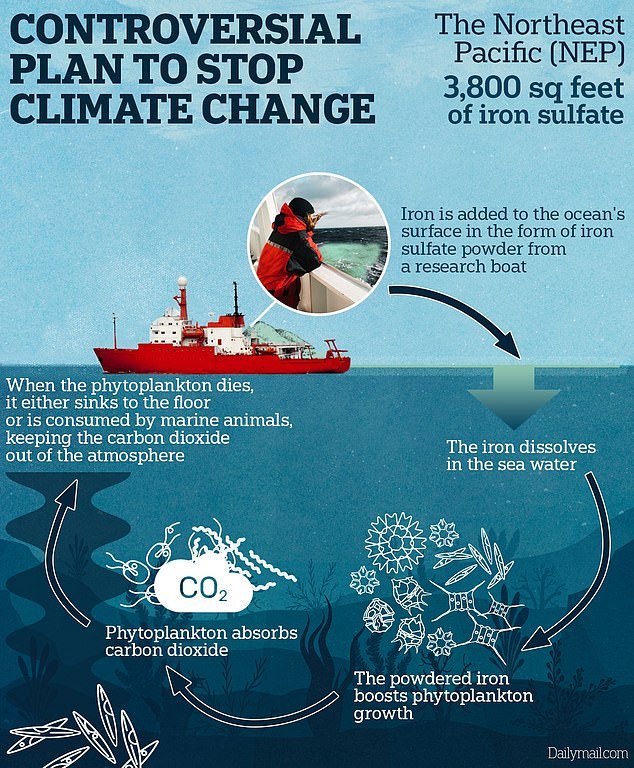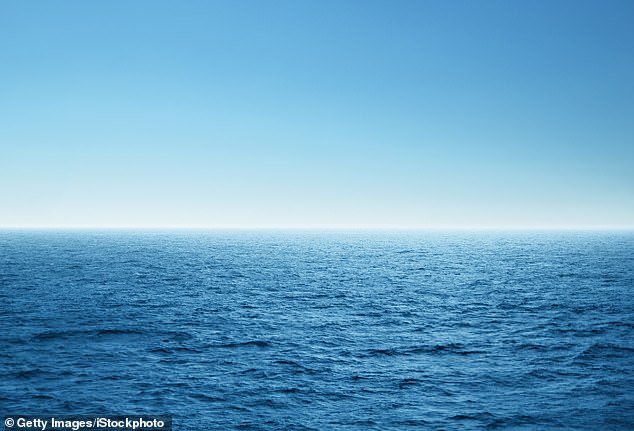Scientists have developed a controversial way to combat climate change – lining a vast area of the Pacific Ocean with iron.
This process, called ocean iron fertilization (OIF), drops a powdered form of iron onto the ocean surface to cause tiny marine plants called phytoplankton to grow, which consume carbon dioxide and trap the gas in the ocean.
Computer models have shown that by removing about two million tons of metal from the ocean each year, the effort would remove about 50 billion tons of carbon dioxide per year. 2100.
The researchers plan to release the metal in a 3,800 square kilometer area in the northeast Pacific by 2026.

Iron can help phytoplankton thrive and absorb carbon dioxide from the ocean, preventing it from entering the Earth’s atmosphere.
A team of scientists from the non-profit organization Exploring Ocean Iron Solutions (ExOIS) is investigating spreading iron sulfate in areas where nutrients are scarce.
This includes the Pacific Ocean in the northeast that extends from the west coast of North and South America to the east coast of Asia and up to the Arctic.
By distributing iron to these areas, scientists can boost phytoplankton growth, keeping carbon dioxide out of the atmosphere for years to come.
It is important to remove CO2 from the ocean, which can help reduce climate change by reducing greenhouse gases from the atmosphere.
About 40 million tons of carbon dioxide are released into the atmosphere every year, and the oceans absorb about 30 percent.
Researchers hope that by distributing iron sulfate in the ocean, they will help the world limit global warming to 2.7 degrees Fahrenheit.
However, analysts have warned that iron can destroy nutrients in marine life, killing the availability of seafood.
But the plan is still going ahead, with only two years to go.
Now scientists are working in a certain way turning the metal into a powder that can easily dissolve in water and spread to the target areas of the sea.
When iron dissolves, it acts as a stimulant to phytoplankton, helping it to grow rapidly, sometimes within days.
The nutrients increase a young plant’s photosynthesis – the process of using sunlight to convert carbon dioxide and water into energy – by 30 times its normal output.

Scientists revived the idea of distributing iron in the ocean to combat climate change
When phytoplankton die, the CO2 they absorbed will also sink to the ground, preventing it from escaping into the atmosphere.
Many experiments were conducted in the 1990s and 2000s, including an experiment in the northeast Pacific in 2006 that succeeded in making phytoplankton thrive.
Despite its success, some researchers have expressed their concern that OIF may negatively affect other parts of the marine environment.
‘Most likely [iron fertilization] it’s going to affect something we don’t really understand,’ deep ocean scientist Lisa Levin, who was not involved in the ExOIS program told Scientific American.
Scientists worry that OIF can create ‘dead zones’ that allow algal plants to grow and consume all the oxygen in the water, killing all other living things.
Before the researchers can begin their efforts, however, they must collect $ 160 million to support this program, but so far they have received $ 2 million from the National Oceanic and Atmospheric Administration.
They also need to apply for a permit from the US Environmental Protection Agency to conduct tests after an international ban on marine iron fertilizers was put into commercial use in 2013.
The ban does not apply to OIF for research if it is carefully monitored and will not harm the environment.
#Scientists #unveil #controversial #plan #pack #Pacific #Ocean #iron
